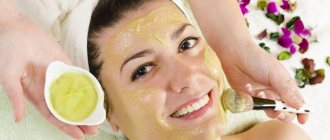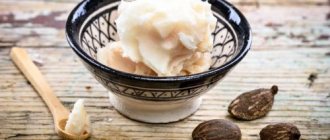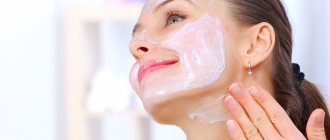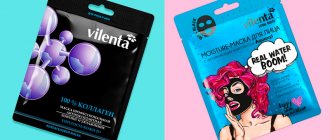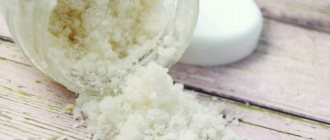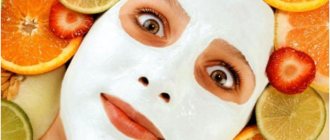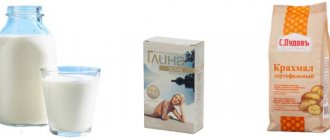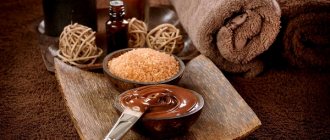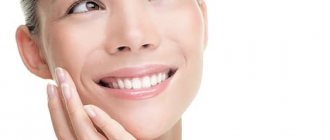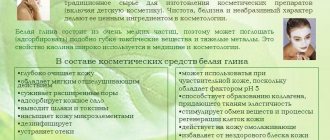A very long time ago, women discovered an excellent product that can cleanse the skin - a scrub. But not everyone knows how to properly use a facial scrub in order to achieve the desired result without harming the skin.
Let's look into the intricacies of such cosmetic manipulations to get the maximum effect on your appearance.
Main components
It should be understood that this is not just a cosmetic product, but a complex mixture. It contains a softening base, as well as an abrasive, the action of which removes all existing impurities from the surface of the skin.
The basis of a scrub prepared at home with your own hands can be sour cream or kefir, honey or eggs, and the abrasive will be salt or sugar, cereals or eggshells, ground coffee or nuts.
Some components will successfully have a healing effect: anti-inflammatory or antibacterial.
How to apply a clay mask on your face: instructions
Clay Mask
Clay face mask is one of the most popular products. At the moment, you can buy a dozen of its varieties. How to apply a mask to this type of face?
In fact, clay masks are a fairly cheap product, but at the same time they are no worse in effectiveness than expensive ones.
Application is carried out as follows:
- First, the skin is cleansed of impurities. It should be completely free of cosmetics, and scrubbing can also be done before the procedure.
- After this, dilute the clay with water. The proportions may vary, but the manufacturer always indicates them on the packaging. Please note that it is better to do this in a plastic or ceramic container, but not metal, and also take a spoon made of silicone or wood.
- After completing the preparation, apply a thick layer of the resulting mask to your face and leave it for a while.
- If the mask starts to dry out faster than you expected, then spray it with thermal water, otherwise it will take moisture from the skin.
- To remove the mask, first wet it generously with water and only then remove it.
- After the procedure, use a cream to moisturize your face.
How often can you use a facial scrub?
It is usually recommended to apply once or twice a week. You will be able to constantly get rid of dead cells without damaging the delicate skin of your face, leaving it without protection.
For those with problematic skin that is too sensitive and prone to irritation, it is not recommended to use it more than three to four times a month.
But if the skin is dry, you will have to limit yourself to two or three procedures per month.
What can you apply after a face mask - should you apply cream or not?
Cream after a face mask?
When deciding how to apply a mask to the face, it is important to understand that after the procedure the face also requires care. But this does not always happen. The fact is that if the procedure is carried out in the evening, then, in principle, there is no need to give additional care to the skin. Cosmetologists advise applying cream only if the procedure is carried out during the day and you plan to go outside. In this way it will be protected from external influences.
It happens that the cream is applied as additional care. For example, when procedures are carried out to eliminate rosacea. In this case, the cream is an additional moisturizer.
In general, depending on the type of mask, cream may or may not be required. In this case, carefully read the instructions. It should indicate whether additional care is required after the procedure or not. Moreover, after clay masks, the cream must be applied, even if the skin is oily. In addition, the cream must be used if the mask has an aggressive effect. This applies to exfoliating, cleansing and rejuvenating products. In addition, if there is discomfort on the skin in the form of tightness, redness and irritation, then a cream is also used.
It is important to understand that the product must be carefully selected for your skin type.
How to use the scrub correctly?
We list the basic principles of application:
- When cleansing your facial skin, never use a body scrub, much less a foot scrub. They contain more abrasive particles, and they are always larger. You will certainly injure your skin.
- The most suitable time for the procedure is the evening, when you are getting ready for bed and definitely won’t go outside with steamed skin.
- It would be correct if you took a bath or showered before the procedure. Steamed facial skin is easier to clean.
- The scrub is applied to damp skin. Therefore, wash your face with water first. Apply the mixture with your fingertips, and then for another two minutes continue to slowly massage in circular movements along the massage lines: from the middle of the forehead to the temples, and from the middle of the chin to the earlobes.
- It is better to wash off the composition with warm water, and after it it is advisable to apply a nourishing cream. Remember that the scrub should not be applied to the most sensitive areas where the skin is especially delicate (around the eyes and lips).
- If there is tingling, itching and redness that does not go away after a couple of minutes, this product is not suitable for you, or you are using it too often.
- If the skin has irritation and various rashes, it is not recommended to use the scrub. You'll only make it worse.
How can you apply a mask to your face?
How to apply a mask on your face?
If you are wondering how to apply a mask to your face, be sure to first find out how to do it. In fact, there are only two options - hands and arms. In principle, you can use what is more convenient for you, but cosmetologists always recommend using brushes, because they are better able to distribute the product on the face.
Deep cleansing of facial skin
Deep facial cleansing is divided into two options: home and salon. We will talk about salon procedures in another article, but now we will try to decide how to perform effective home peeling of facial skin.
Actually, the name “peeling”, derived from the English “peeling”, meaning removal, exfoliation, combines the use of products for deep cleansing of the face, that is:
- establishing cellular respiration;
- removal of dead epidermal cells;
- freeing pores from dirt, excess cosmetics, sebaceous plugs;
- prevention and treatment of certain skin imperfections.
Contrary to popular belief, peeling can and should be used to care not only for oily and combination problem skin with enlarged pores, but also dry, age-related, mature skin.
Clay facial scrub - traditional medicine recipes
Natural clay scrub at home - used on the face as an absorber of oil, dirt and toxins. Using a scrub with clay: stimulates blood circulation, acts as a medicinal and cosmetic product that tightens pores, cleanses and smoothes the skin surface. 1. Regenerative Recipe: Mix two tablespoons of clay powder, a tablespoon of thyme and a tablespoon of dried sage leaves. Add two drops of thyme essential oil and two drops of sage essential oil, then gradually dilute the resulting powder with hot water to form a thick paste. Apply the product to your face and rub over the skin with your fingertips.
—//—//—
2. White Clay Exfoliating Scrub: You will need two tablespoons of rhassoul clay powder, one tablespoon of white clay, one tablespoon of cornstarch, one tablespoon of dried flowers or herbs (such as a mixture of rose, chamomile and lavender), essential oils.
If you don't have white clay on hand, using two tablespoons of cornstarch is sufficient.
Mix the clay powders, then add starch and dried crushed flowers, you can add a few drops of essential oil of your choice. Mix everything and pour into a glass jar with a tight lid. When using, sprinkle some powder on your palm and dilute it with a little water to form a thick paste and apply to face and neck. The product can be used morning and evening two to three times a week.
To create a nourishing scrub, use vegetable oil, rose water, aloe vera gel, milk, yogurt, cream, infusion, liquid honey instead of water.
—//—//—
3. Clay scrub for oily skin with enlarged pores: Take half a teaspoon of coconut flakes; half a teaspoon of green clay; half a teaspoon of ground oatmeal. Mix everything thoroughly and add a small amount of boiled or still mineral water. Apply with gentle movements onto the face, paying special attention to the T-zone.
—//—//—
Green clay scrub to give your skin a healthy glowing color: You will need yeast - two teaspoons, one tablespoon of water, one tablespoon of liquid honey, half a tablespoon of yogurt, one tablespoon of green clay. Mix the yeast with water and let it sit for half an hour, then add honey, clay and yogurt, mix well. Apply the mixture to your face with massage movements, then rinse first with warm water, then with very cold water to tighten the pores.
—//—//—
Recipe for a clay scrub to remove blackheads on the face: Mix green clay with water and add a teaspoon of warmed sage oil. You should get a semi-liquid mass that will lie softly on the skin and glide lightly over your fingers. Apply the product onto your face using gentle movements, excluding the area around the eyes. If you have time, leave the mixture on the skin for a quarter of an hour and then rinse with water.
—//—//—
Clay Facial Scrub: You will need one large ripe strawberry, half a teaspoon of green clay powder, half a teaspoon of dried lavender powder. Mash a large juicy strawberry, add clay and lavender to it, and grind the mixture. After cleansing the skin, for greater effectiveness, the mass can be left on the face for 15 minutes.
—//—//—
This exfoliating clay scrub can be used for all types of facial skin: Combine a tablespoon of chopped almonds with one tablespoon of clay, previously diluted with honey. The consistency of the mixture should resemble thick dough. Apply the product to moisturized skin, leave for 2-3 minutes, then rinse with warm water. ◦ Homemade scrubs for cleansing the skin ◦ Scrub recipes for oily facial skin
—//—//—
Delicate scrub recipe: Take half a teaspoon of ground almonds, half a teaspoon of clay powder, half a teaspoon of ground oatmeal. Combine the ingredients, fill them with warm water to form a thick paste and apply with light movements to the skin of the face for 2-3 minutes, then rinse with cool water.
How to properly apply a fabric mask to your face: instructions
Fabric mask
Fabric masks are a means for quick skin care. Despite the ease of use, the question still arises of how to apply a mask to this type of face.
In fact, there is no need to invent anything special here. Just a cloth soaked in care product is evenly distributed on the face. After the procedure, you don’t even need to wash off anything. Just so that the composition is well absorbed into the skin, it must be applied correctly to the face.
- First, cleanse your skin of impurities.
- Then open the mask and remove it from the packaging
- Place the napkin on your face and try to smooth it out as much as possible. Then it will completely cover the surface of the skin
- Leave the product on the skin for the time indicated on the package
- After completing the procedure, do not wash off the remaining product, but simply rub it gently into your face.
- If desired, the result can be secured with cream.
What are the benefits of body scrub?
A scrub is a cosmetic product that has a number of beneficial properties. The main thing is not to make basic mistakes in this procedure. For example, the skin needs to be prepared for the procedure by first cleansing it with shower gel. Apply the scrub in a circular motion, moving from below, from the very feet, upward, dispersing blood and lymph and improving their microcirculation. How to apply the scrub? Hands or special gloves.
What effects can you expect from scrubbing? What does the scrub give?
- cleansing effect: solid particles easily remove dirt;
- nutritional effect: in addition to solid particles, the product always includes a nourishing and/or moisturizing base;
- toning effect: improved microcirculation keeps body skin toned;
- tightening effect: the scrub works like a massage, which means the lifting effect will not take long to arrive;
- a whole SPA ritual: often the products contain beneficial essential oils.
We hope you'll reconsider your basic bathroom makeup bag and find a place for your scrub on the most prominent shelf.
